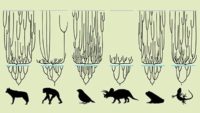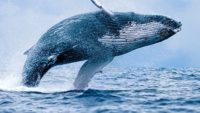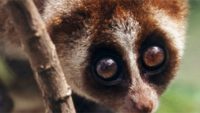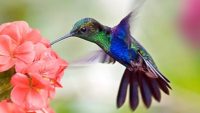It actually speaks against Darwinism! …read more Source: creation.com
By Dr. Georgia Purdom Epigenetics, a field of science, displays the providence of God to help organisms adapt and survive in a fallen world which helps explain beneficial mutations. …read more Source: AIG Daily
By Harry F. Sanders, III Phylogenetics, the proposed evolutionary history of a species (or group of species), ultimately fails because of flawed scientific and philosophical assumptions. …read more Source: AIG Daily
A recent study, from the University of Exeter in England, provides insight into how and why European pine martens need each other—but also like to keep their distance from each other. The research also covered how the presence of pine martens affects the behavior of local squirrels.1-3 European pine martens are weasel-sized, smaller than many domestic cats, and move about in woodlands. Many have tracked ranges that… More… …read more Source: icr.org
Wandering albatrosses have the largest wingspan of any living bird, so they live much of life soaring above the oceans. With their wings—and a lot of winds—it is no wonder that their use of wind-power would be studied by scientists, as a recent report illustrates.1,2 And, because albatross males are bigger, they need more wind. A new study of albatrosses has found that wind … More… …read more Source: icr.org
Chinese researchers recently reported on venomous toxins of the giant jellyfish. They revealed that this aquatic creature mixes a “cocktail” of toxins to produce stinging agony and sometimes death unto its victims.1,2 Jellyfish stings are a major threat to human beings in coastal areas of the world. Each year, hundreds of thousands of victims are stung by venomous jellyfish…. More… …read more Source: icr.org
Dolphins—like other cetaceans such as whales, wholphins, and porpoises—are highly intelligent marine mammals, capable of astonishing feats. A recent University of Leeds study, led by Sonja Wild, adds to what we humans have learned about what and how dolphins learn.1,2 Dolphins catch fish as prey by a mix of programmed instincts and learning.3,4 One example of learned fish-catching be… More… …read more Source: icr.org
By Troy Lacey Whale evolution is presented in most biology textbooks as absolute fact, often with inaccurate depictions of the supposed transitional forms. …read more Source: AIG Daily
A study led by Oxford University researchers was recently published confirming that Neanderthals and humans were very genetically similar and interfertile. They were even closer than polar and brown bears are to each other, which are known to mate and produce viable offspring in the wild quite easily.1 Along with a plethora of previous DNA studies, this research further confirms that Neanderthals were an ancient people group of the hum… More… …read more Source: icr.org
By Joel Ebert The slow loris’ large eyes have a reflective layer to help them see in almost total darkness. …read more Source: AIG Daily
A pair of new studies found that some dinosaurs, and possibly some marine reptiles, laid squishy eggs. One study discovered that many dinosaurs, like turtles and snakes, laid soft leather-like eggs—not hard-shelled eggs like most birds.1 A second study found a massive leathery egg about the size of a football in Cretaceous sediments in Antarctica.2 However, they think it was from a marine reptile and not a dinosaur.More… …read more Source: icr.org
Is it a safe and healthy practice to build using lots of timber, or not? Some French and Norwegian policy-makers say yes, while some British policy-makers disagree.1 The French support their enthusiasm for constructing buildings with lots of wood, assuming that doing so somehow helps save the planet from manmade global warming. They argue that “timber construction … [helps] trees lock up climate-heating carb… More… …read more Source: icr.org
By Ken Ham For hundreds of years, we’ve classified organisms according to the system developed by Carl Linnaeus. Organisms fall into various kingdoms, phyla, classes, orders, families, genera, and species. It’s a time-honored method of categorizing what God has made. But some scientists are trying to change this. As you can see, this new system of classification is entirely based on the evolutionary tree of life and the idea that all life had a common ancestor. As one popular science article begins, “Move over, Linnaeus: There’s a new way of naming organisms.” This new system is known as the PhyloCode [More]
By Ken Ham Our head of horticulture at the Ark Encounter told my wife, Mally, and me that the large firecracker plant (Vermillionaire Cuphea) was the best plant to attract hummingbirds, so my wife put one on our deck. It didn’t take long. While I was sitting on the deck, a beautiful female ruby-throated hummingbird—the only breeding hummingbird species in eastern North America—came up to the plant and I was able to snap a couple of photos with my smartphone. Worthy are you, our Lord and God, to receive glory and honor and power, for you created …read more Source: [More]
Once again, a scientific study shows how “farmed” or ranched creatures live better if their domesticated context resembles their natural habitat.1 According to a recent study published in Aquaculture Reports, confined fish at Brazilian farms raising Nile tilapia (Oreochromis niloticus), fared better if they had an assortment of shelter-like structures and/or artificial plants.2,3 As a fish that … More… …read more Source: icr.org
As June transitions into July, it’s time for fruit harvesting—including apples, peaches, pears, and cherries. Notice how fruit phenology (seasonal life cycles) is linked to the timing of agricultural harvesting. As peach thinning continues, the first fruits are ready to be harvested; sweet cherries in mid-June and sour cherries in late June or early July. July also brings ripe plums, t… More… …read more Source: icr.org
A complex metabolic process called Chaperone-Mediated-Autophagy (CMA) was thought to be a recent evolutionary development in land vertebrates as it was only previously documented in mammals and birds. Now it has been found to be fully operational in fish—once again demonstrating that a lack of human knowledge is not evidence for evolution.1 Autophagy is an amazingly complex and ingenious process in which cells are … More… …read more Source: icr.org
Have Trinidadian guppies learned evasive maneuvers from Spanish bullfighters? Recent research published in the journal Current Biology1 reports how gutsy guppies confront a regular predator, the voracious pike cichlids, like a matador. They attract the attacker to a location that can be dodged from. Then, at the last instant, the guppy pivots to safety.1-3 Trinidadia… More… …read more Source: icr.org
The social behavior of ants continues to amaze scientists with its complexity and efficiency of organization and design. In a new study, scientists have shown how ant communities foraging for food and other resources embody a complex system of behavior and path marking that creates an optimized search with minimal waste of energy and time.1 The information gleaned from this study was then applied to the design of computer search algori… More… …read more Source: icr.org
For a generation of millions (maybe billions) of North American jumping bugs called cicadas—often mislabeled in America as locusts—life changes dramatically after 17 years, yet for others the special timeframe is 13 years.1,2 And for many such periodical cicadas, reports Kirsten Geddes, it’s about that time. Cicadas, those little bugs that make … More… …read more Source: icr.org
Recently, after audio-recording underwater in Greenland’s fjords, two geoscientists published research on vocalizations made by narwhals. The sounds included shrill whistle tones, repetitive clicks, knocking sounds, buzzing noises, and even some tonal pulses inaudible to human ears.1,2 Complicating the situation, narwhals routinely summer near calving icebergs, so their natural surroundings are often noisy. More… …read more Source: icr.org
Evolution is often claimed to explain something and its opposite, so it certainly should not be called science, rather an unfalsifiable ideology! …read more Source: creation.com
An amazing abundance of life can be found in the strangest places—such as the backs of turtles. It was previously known that an array of life was present on the backs of loggerhead sea turtles, and new research shows that it’s more abundant and diverse than scientists ever realized.1 An international group of researchers, headed up by Florida State University scientists, discovered more than double the total nu… More… …read more Source: icr.org
European dippers are making the news lately, including science news in Wales.1-3 These riparian habitat birds are indicators4 of freshwater stream quality, as noted below. Scientists study them to learn how badly freshwater streams are polluted—such as by non-biodegradable (non-decaying, indigestible) plastic waste products.2,3 Birds living on … More… …read more Source: icr.org
By Dr. Jennifer Hall Rivera The amazing design of fingerprints helps us get a good grasp on God’s Word. …read more Source: AIG Daily
Recent research surprises those who study coral reefs, especially those who assume that they grow slowly.1,2 To the surprise of old-earth evolutionists, these findings reveal that reef ages do not conflict with relatively young biblical chronology timeframes. New research at the University of Hawai?i at M?noa revealed unexpectedly high growth rates for deep water photos… More… …read more Source: icr.org














































